What Size Of Tornado Hit Kcmo Today
Overview
Since 1950, more than than 300 tornadoes take been reported in the area now served by the National Conditions Service Forecast Office in Pleasant Loma. The majority of tornadoes take been classified as weak to moderate tornadoes, the most common types of tornadoes to affect all parts of the U.s.. On rare occasions, less than twenty percent based on official records, the Kansas Metropolis surface area and the surrounding expanse has experienced significant tornadoes. The most destructive and deadly of these tornadoes occurred on the evening of May 20, 1957. The tornado event of May 20, 1957 thereafter earned the local moniker of the Ruskin Heights tornado due to the farthermost devastation and loss of life that occurred in this Kansas City neighborhood.
"Ruskin Heights Tornado"
Though labeled the Ruskin Heights tornado, the tornado actually began its 71 mile path virtually Williamsburg, Kansas at 6:xv pm LST. Below is an image taken from the cover of the official impairment report of the "Kansas-Missouri" tornado. Though postal service-mortems of major tornado events are common today, only two damage reports were conducted for tornadoes in 1957, one of them for "Kansas-Missouri" or Ruskin Heights tornado. The tornado earned the most extreme damage rating of that fourth dimension, F5, as it carved a path ranging from 1-10th to nearly one-half mile wide (700 yards) sped northeast at approximately 42 miles per 60 minutes. The Ruskin Heights tornado was 1 of thirty-five confirmed tornadoes that impacted areas of Colorado, Kansas, Nebraska, Oklahoma and Missouri on May 20, 1957, including a devastating tornado accompanied by hail seven inches in diameter that struck Concordia, Kansas. The watch network that in the present day provides such valuable information to the National Weather condition Service was not in place in 1957, explaining the sparsity of hail and damaging wind reports displayed in the graphic study.
Meteorological Conditions
The meteorological conditions present on May twenty, 1957 were prime number for severe thunderstorm development, namely supercell thunderstorm development. The graphics beneath draw a blended of the surface and upper level weather that existed prior to the development of the Ruskin Heights tornado. Key ingredients included a progressive upper level storm arrangement that focused the jet axes at 850 mb (green), 500 mb (red) and 300 mb (light blueish) over Kansas City (Figure 3) and a well-developed surface frontal system, with a low centered over south central Nebraska (Figure iv). The interaction of these features helped to provide a focus for thunderstorms to develop intially across northeast Colorado, with the beginning tornado of the solar day touching down effectually 11:00 am LST in Kit Carson, County and tracking north of Goodland, Kansas. Tornadoes and severe thunderstorms spread across Nebraska and Kansas during the afternoon hours on 5/20/1957. As the frontal system moved e beyond the plains, a steady influx of low level moisture from the Gulf of Mexico provided the fuel for connected thunderstorm evolution into the nighttime hours of 5/20/1957 beyond northeast Oklahoma, northeast Kansas and northwest Missouri. By xi:00 pm LST, the threat of severe atmospheric condition had subsided in the region, but 5/20/1957 would go down in the record books. In addition to the severe conditions that occurred in Kansas City and the surrounding surface area on May 20th, severe weather was reported across the primal plains and Midwest states on May 19th and May 21st as well. In fact, the menses of May nineteen-26, 1957 would be recognized equally one of the most active period of tornado occurrence, in the newly formed U.Due south. Weather Bureau'southward being. At week'due south cease, the U.South. Weather Bureau logged the highest i-day tornado count always recorded in the United States on v/20/1957: 50 twisters whirled beyond the central Plains and Midwest (Fourth dimension Magazine, 6/3/1957).
The upper air sounding network that meteorologist rely upon to assess the instability and air current shear in the atmosphere was not as dense in 1957 as it is today. In the local expanse, atmospheric soundings were taken at Topeka, Kansas and Columbia, Missouri. Routine soundings of the atmosphere were taken at 9:00 am LST and nine:00 pm LST, with soundings taken as needed at 3:00 am LST and 3:00 pm LST. The Topeka, Kansas sounding taken at 9:00 pm LST is shown beneath (Figure 5), the launch occurring soon afterwards the tornado struck. Meteorologists appraise the instability of the temper by analyzing the thermal profile of temperature and moisture, depicting in black and green respectively, through the depth of the atmosphere. The blood-red and orangish curves to the right of the temperature profile provide meteorologists with an idea of the convective bachelor potential energy (Greatcoat) in the atmosphere. In this instance, the chart is depicting near 3000 J/kg (Joules per kilogram) of energy that tin be tapped. In general, meteorologists look for Greatcoat values in excess of chiliad J/kg when forecasting severe storm development. Atmospheric vertical air current shear controls the arrangement of thunderstorm development. To assess the wind shear of the atmosphere, meteorologists audit the wind contour through the depth of the atmosphere. On May 20, 1957 the atmospheric air current profile displayed a clockwise change in wind direction from the surface upwardly through 30,000 anxiety in the atmosphere. This type of atmospheric wind contour often is associated with rotating or supercell type thunderstorms (Figure vi).
Chronology
The severe sentinel and warning program in place today's National Weather Service was not in existence in 1957. Hazardous conditions forecasts and warnings were issued past commune forecast centers, while radar surveillance was performed at local observing sites. In 1957, the local weather condition and radar observation office in Kansas City was located at Kansas City Municipal Aerodrome (Charles Wheeler), whereas the district forecast office recently had moved to the Federal Building located at 911 Walnut. Co-located with the commune weather condition forecast function was the Severe Local Storms Unit (SELS), which had transferred to Kansas City in 1954, and the Aviation Forecast Unit. The use of radar to notice atmospheric condition phenomena was a new engineering during the 1950s. The radar network in identify during the 1950s was equanimous of a hodge podge of excess armed services radars that were used during World War II. The U.S. Atmospheric condition Bureau had installed a new radar (WSR-57, 10 cm) on top of the Federal Building several months prior to the Ruskin Heights tornado; however, the radar was not operational on that fateful twenty-four hour period. The radar operator at the Kansas City Municipal Airport on May 20, 1957, Mr. Joseph Audsley, performed radar surveillance using an older radar (WSR-1, ten cm). Advice between local weather part and SELS was achieved by teletype. In addition, teletype was used to disseminate weather condition-related data to the media. The post-obit is a transcript of U.S. Weather Bureau teletype messages issued on May 20, 1957. The transcript is supplemented with additional information chronicled past Joseph Audsely, as well equally, Allen Pearson and Hugh Chiliad. Crowther formerly of SELS. You will note that the terms "tornado warning" and "astringent thunderstorm warning" are non included in this transcript, as these terms were not part of the U.S. Weather Bureau dictionary at the time. May xx, 1957 - eleven:00 am LST Severe Weather Forecast #167 issued past Astringent Local Storms Forecast Unit that highlighted the threat of severe weather, including tornadoes, for a large area that encompassed the Kansas City area.
 |
| Click on prototype to view larger size |
| Figure 7. Astringent Weather Watches and Initial Tornado reports from 05/20/1957. Courtesy of "A Kansas Metropolis Area Guide to Severe Thunderstorms and Tornadoes" past Charles Doswell & Fred Ostby, August 1982. |
May twenty, 1957 - 1:30 pm LST Severe Conditions Forecast #167 updated by Severe Local Storms Forecast Unit. May twenty, 1957 - 3:28 pm LST The Weather Bureau Function in Concordia, Kansas reported a tornado six (6) to seven (7) miles southeast of the office (Figure 2 and Figure 7).
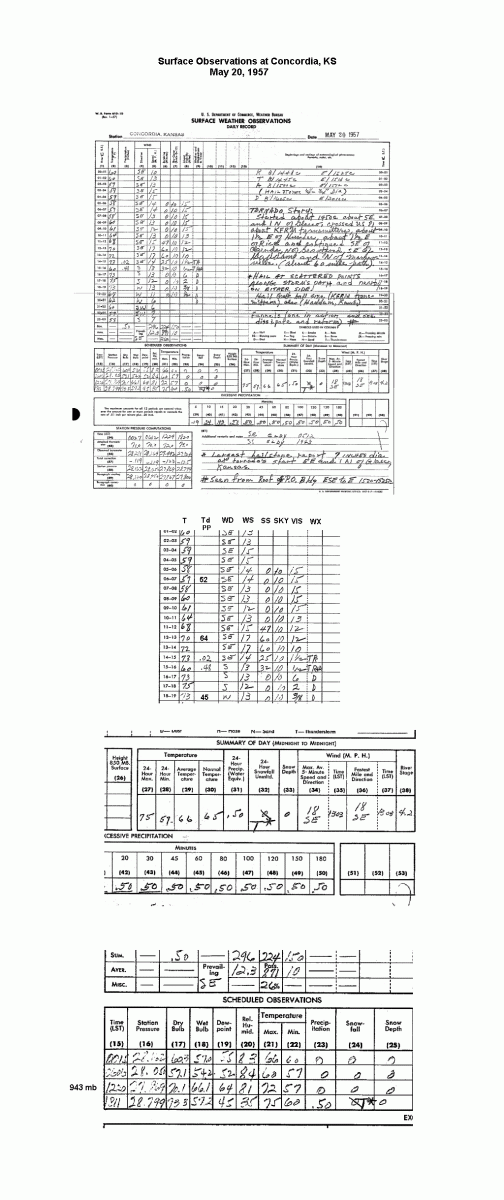 |
| Click to view larger image |
| Figure 8. Surface observations taken at the U.South. Conditions Agency office located in Concordia, Kansas on May xx, 1957. |
Severe Local Storms Units consolidated Severe Weather Forecast #167 and #168 into a new forecast surface area - Astringent Weather condition Forecast #169. Severe Conditions Forecast #169 called for "Scattered severe thunderstorms and several tornados (sic) for the rest of the afternoon and until 9:00 P.Thousand. this evening. This area is bounded by a line from 40 miles north of Grand Isle, Nebraska, to Salina, Kansas, to thirty miles west-northwest of Wichita Falls, Texas to McAlester, Oklahoma to Joplin, Missouri to l miles southeast of St. Joseph, Missouri to twenty miles west of Des Moines, Iowa to 40 Miles north of Grand Island, Nebraska." May 20, 1957 - 5:06 pm LST Update to Severe Weather Forecast #169 "Over Kansas and Missouri this afternoon the weather ranges from heavy thunderstorms activity to dry, windy and dusty. Strong southerly winds over much of the area accept brought moisture to some sections and causing blowing dust over vast portions of Kansas. In that location have been numerous tornados in Kansas and up in Nebraska. The latest radar report from Kansas City shows an expanse of thunderstorm activity about 60 to 70 miles north and another surface area about 100 miles southwest. Forecast calls for: Thunderstorms over due east sections of Oklahoma and Kansas and across Nebraska, Iowa and Missouri. Thunderstorms may be heavy tonight in southeast Nebraska, southwestern Iowa, extreme northwest Missouri, eastern Kansas, central and northeast Oklahoma. Temperatures will stay mild tonight over Missouri with cooler weather in store for southwest Kansas and western Oklahoma."
May twenty, 1957 - four:xxx pm LST
May 20, 1957 - v:30 pm LST Update to Astringent Weather condition Forecast #169 "A severe thunderstorm at Emporia, Kansas was giving hail upwardly to 1 inch in diameter radar at the Kansas City conditions bureau showed the tempest to be very astringent and moving northeastward in the general management of Kansas City at well-nigh 50 miles per hour. This storm volition be kept under shut surveyance by atmospheric condition bureau radar and any changes in it's course and it's intensity volition be reported at once on this circuit. For the present it appears that Kansas Metropolis may await high winds, accompanied by hail by 8:00 P.Grand. this evening or shortly before. six:00 P.M. temperature 80." May 20, 1957 - vi:05 pm LST "The severe thunderstorm mentioned at 5:thirty P.M. at Emporia, Kansas is now centered 55 miles southwest of Kansas City and continues to move in this direction. Information technology is at present several separate cells and is however severe. Further advice follows: Cooperative observer at Marysville, Missouri reports two tornadoes in the vicinity of Marysville between 4:00 and vi:00 P.Thou. this afternoon. Neither tempest did whatsoever damage." May 20, 1957 - six:15 pm LST Tornado that would get on to ravage Ruskin Heights touches downwardly 2 miles southwest of Williamsburg, Kansas. As the tornado moved northeast through farmland north and due east of Williamsburg, it brushed the town of Homewood, Kansas. Around Homewood, witnesses reported multiple funnels, the chief one of which caused massive harm beginning at the Antioch Cemetery northeast of Homewood. Head stones from the cemetery were carried for miles. One eyewitness recalled seeing a greenish-grayness cloud turning violently. "Tentacles were reaching downwards out of the cloud and billowy off the basis," one eyewitness recalled. "Five and up to 10 tentacles came down and joined together." Next the tornado skirted forth the hill on the southern fringe of Ottawa, where information technology did the impairment to the U-Rest Motel, Bob's Truck Stop, Hillcrest Bulldoze-In and surrounding expanse. Ten guests were registered at the motel, and operators Mr. and Mrs. Glenn Geiss took them into their home and into the basement, while the owner of the restaurant gathered his patrons into a station wagon and drove all of them safely to the south. (Ottawa Herald, 5/20/2000) The first two victims of the tornado were reported almost two and one half miles east of Ottawa when the tornado slammed into the home of an elderly couple merely sitting downwardly to dinner. The twister lifted upward the house and demolished information technology. . May xx, 1957 - 6:30 pm LST "A funnel cloud touching the ground was sighted forty miles Southwest of Kansas City moving northeastward."
The center of the tempest is simply southeast of Baldwin City and is approaching that city.
"Another funnel cloud was sighted in the vicinity of Paola, Kansas moving apace n. The forecast for Kansas Metropolis calls for thunderstorms, perhaps severe with a hazard of a tornado in the greater Kansas City area. A tornado has been reported at Rantoul, Kansas, heading for Lawrence, Kansas. A tornado reported at Spring Hill, about 20 miles due south-southwest of Kansas City."
May 20, 1957 - half dozen:52 pm LST
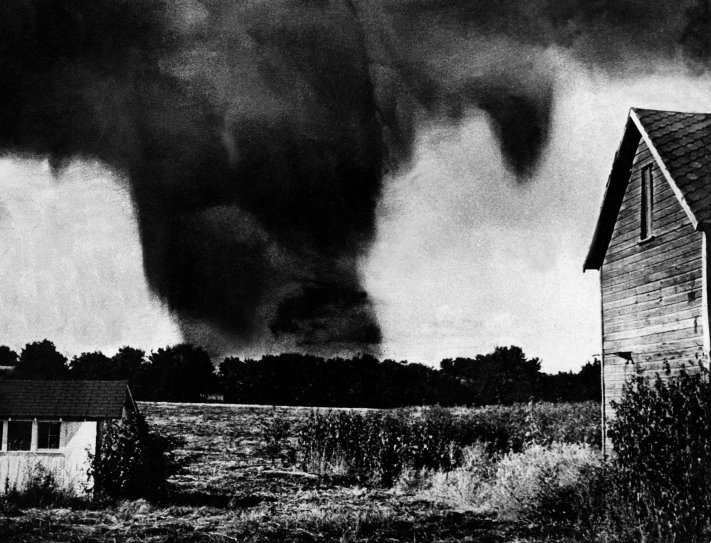 |
| Click on image to view larger size |
| Figure 11. Tornado about Jump Loma, Kansas. Original photograph taken from the north porch of the parsonage of the Methodist Church. Photographer looking northward. Photograph has been cosmetically enhanced. Equally the storm strikes the pocket-sized town of Bound Loma, Kansas, four members of the Isham Davis family were killed. Photo courtesy of Tim Janicke, Kansas City Star. Photographed by Reverend Robert Alexander. |
C
May 20, 1957 - vii:15 pm LST "Radar shows the largest thunderstorm cell from the southwest portion of Kansas City, southwestward to the vicinity of Olathe. There have been numerous unconfirmed reports of tornadoes from this massive storm when it was in the vicinity of Paola and Ottawa, Kansas - it is still a potent storm and will bear watching every bit it moves northeastward over greater Kansas Metropolis." May 20, 1957 - 7:23 pm LST "Radar at the drome shows an echo which appears to be very severe merely 3 or iv miles southeast of Olathe, Kansas, moving northeastward. We have merely this moment received report of a tornado on the basis moving quickly northeastward at this exact spot."
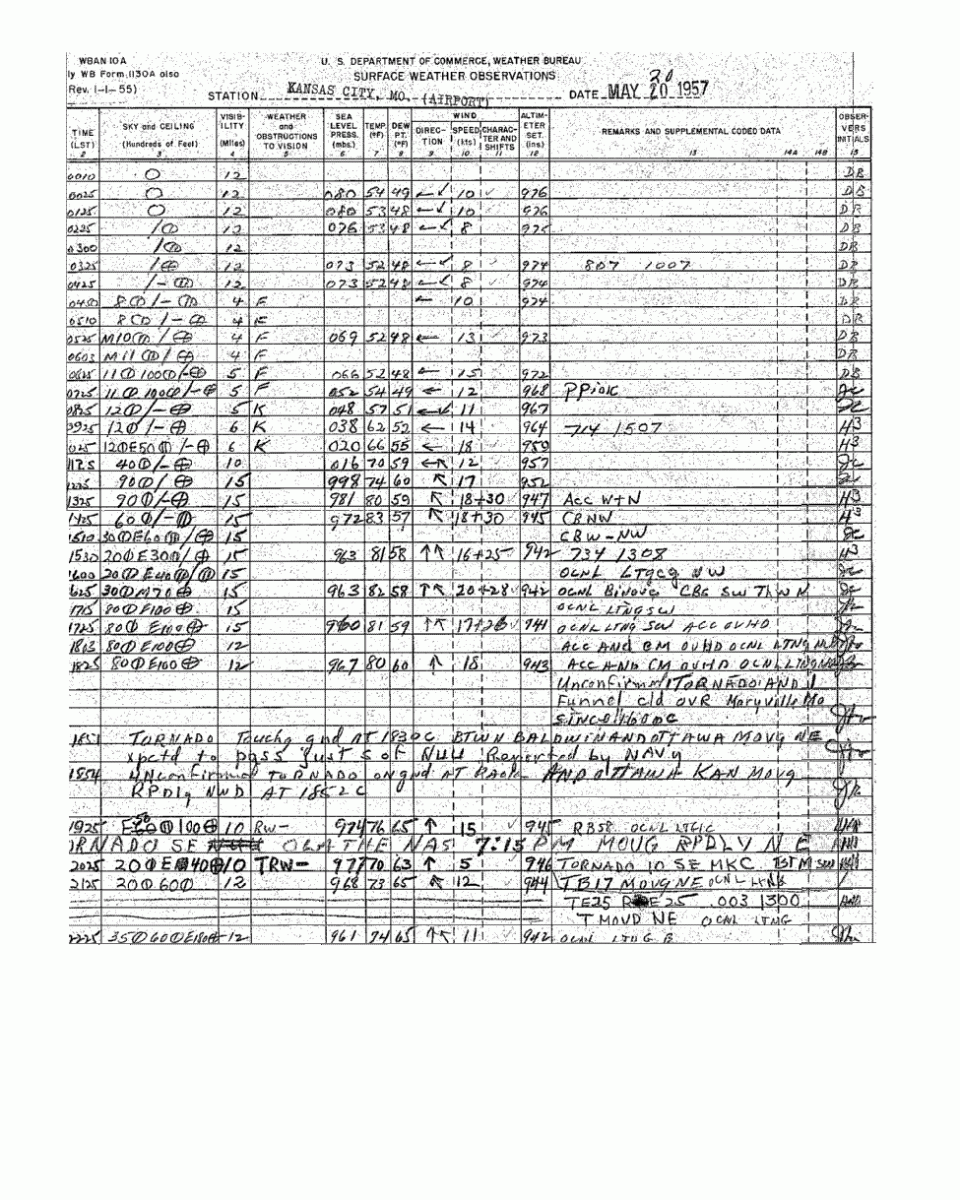
Click on prototype to view larger size
Figure 12. Surface observations taken at the U.S. Weather Bureau part
at the Kansas Metropolis Municipal Airport on May 20, 1957.
May xx, 1957 - vii:37 pm LST "Airline pilot reports funnel cloud 2 miles west of Grandview Airport." The tornado crosses the Missouri-Kansas state line striking the Martin Metropolis area. Twenty-three boys housed at the Ozanam's Boy's home were spared past seeking refuge in the basement. Forty or more celebrants attention a birthday party at a Methodist Church located 135th and Holmes, the current location of the Martin City Melodrama and Vaudeville Company, likewise were spared by seeking shelter. Most every habitation and building in Martin City was damaged or destroyed, including the popular Jess and Jim's Steakhouse though the owner'southward parakeet remained unharmed. Unfortunately, past the time the tornado moved northeast of Martin Metropolis, 2 more people were dead and 35 were injured. May twenty, 1957 - vii:44 pm LST "The virtually severe thunderstorm activity is now to the south and southeast of Greater Kansas City. A funnel has been observed nearly two miles north of Olathe Naval Air Station. Reports signal that the funnel observed 2 miles west of the Grandview Air Force Base was also observed from the basis at the Base. There are astringent thunderstorms through the surface area and precautions should be taken by anybody. Delight report radio listeners not to call the Weather Bureau except to report wind tempest damage or the sighting of a funnel cloud. Half-inch hail and heavy rain at 71st and Woodland. "Weather Alert issued by Weather Bureau Forecast Eye, Kansas Urban center, Missouri:" May twenty, 1957 - 7:45 pm LST "Braniff pilot reports tornado on the ground n of Grandview moving northeast - appears to be headed toward Eastward edge of city." May 20, 1957 - 7:l pm LST "Tornado observed at Holmes Park. Funnel was reaching the ground. This was at 95th and Highway 71." At that place were many foursquare blocks of devastation in Hickman Mills and the Ruskin Heights area, in some places the ground was swept clean, while huge trees were toppled or snapped off. The Hickman Mills Bank at 107th and U.South. Highway 71 lost its due south wall to the tornado and had to be protected by the National Baby-sit. The Hickman Mills Furniture Company was demolished and the cars on both sides of U.S. Highway 71 were tossed about like toys. The storm moved into Ruskin Heights, ripping through the shopping center at 111th and Blue Ridge Boulevard, heavily damaging Ruskin Heights High School and cutting through a thickly populated portion of Ruskin Heights. Because of warnings on radio and television, many Ruskin Heights residents were able to take refuge in their basements or with neighbors who had basements. At to the lowest degree fifty people took refuge in one basement, literally lying on pinnacle of each other, at East 110th street. The roof was diddled off the home, all the same no i was injured. Those that did not seek shelter with neighbors gathered family and friends in automobiles and drove out of the storm's path. Sadly, many people did not escape the tornado'southward fury and 37 lives were lost in the communities of Ruskin Heights and Hickman Mills. May xx, 1957 - seven:53 pm LST Tornado lifted, about two miles north of Knobtown, MIssouri. In it's wake, 44 people lost their life and 531 people were injured. May 20, 1957 - 7:55 pm LST "Funnel observed at 87th and Raytown." May twenty, 1957 - seven:57 pm LST "A funnel observed simply to the South of Raytown." May twenty, 1957 - 7:59 pm LST "However some other funnel reported in the Raytown area, or rather a tertiary report of the funnel being sighted." May xx, 1957 - viii:00 pm LST "A report of the funnel being observed 2 miles West of Raytown. Concluding study from man at 39th and Tracy was tornado was near iii miles northeast of Raytown." May 20, 1957 - 8:ten pm LST "To keep yous up-to-date on severe weather in this area, the mass of thunderstorm which has apparently moved beyond the southern portion of the urban center in recent minutes, is now to the east of the city and this detail storm probably poses no farther threat to the city. There are even so, other stiff thunderstorms from Lake Quivira southward to the Olathe, Springhill area. These latter are moving due east-northeastward and precautions should exist taken by all residents." Several other forecast updates were made through 9:00 pm with an "all-articulate" update issued at 9:00 pm for the greater Kansas Urban center area. May 20, 1957 - 9:00 pm LST "The earlier severe thunderstorm which acquired damage in some southeast portions of Greater Kansas City is now well to the northeast beingness well toward the Chillicothe surface area. In that location are now no radar echos toward the west-southwest or s of the Greater Kansas Urban center area. Therefore a tentative all-clear is now issued and no farther warnings will be issued until or if boosted thunderstorm action develops to the southwest. The Weather Bureau appreciates the many calls that take been received reporting the sighting of funnel clouds or reporting wind damage. Further the radio and idiot box stations of the city take performed a service to anybody in carrying frequent bulletins to the one million people of the Greater Kansas Metropolis region."
Aftermath
The tornado carved a continuous, 70-one mile path of destruction from where it touched down near Williamsburg, Kansas until it lifted near Knobtown, MIssouri. The tornado ranged in width from 175 yards (1-tenth of a mile) to 700 yards (slightly less than one-one-half of a mile) and was on the ground for one hour and 30-eight minutes. The human being toll was significant, 44 people lost their lives, 7 in Kansas and 37 in Missouri, and 531 people were injured. Damage from the tornado was estimated at $2.5 meg dollars. The destructive nature of the tornado can be seen in the numerous damage photos taken after the tornado struck.
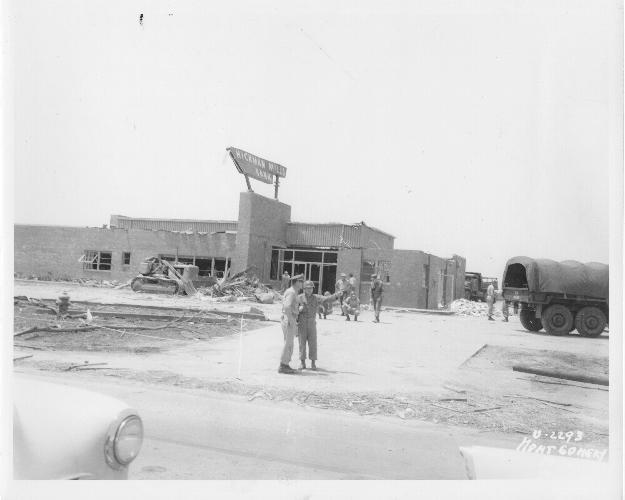 | 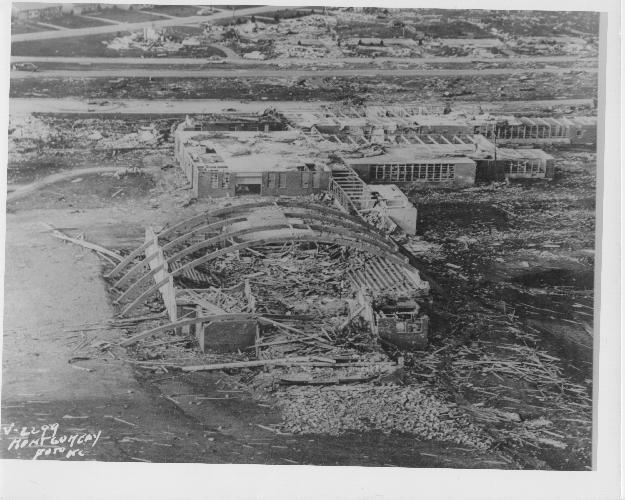 | 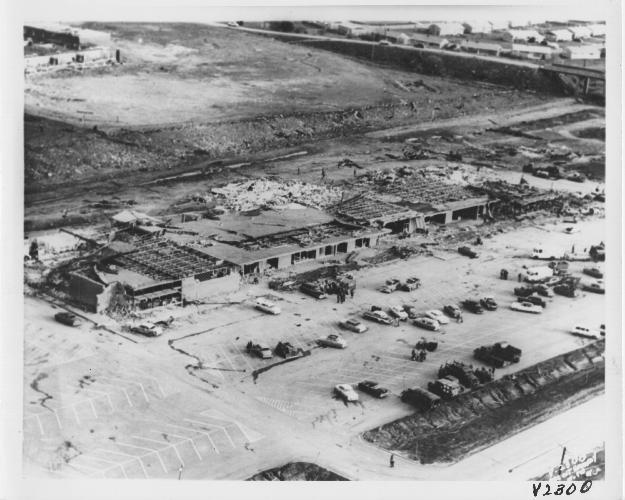 |
| Effigy thirteen. Impairment to Hickman Mills State Bank. Photo courtesy of Kansas Metropolis Star. | Figure 14. Damage to Ruskin Heights High Schoolhouse. Photo courtesy of Kansas City Star. | Figure 15. Damage to Ruskin Shopping Center. hoto courtesy of Kansas City Star. |
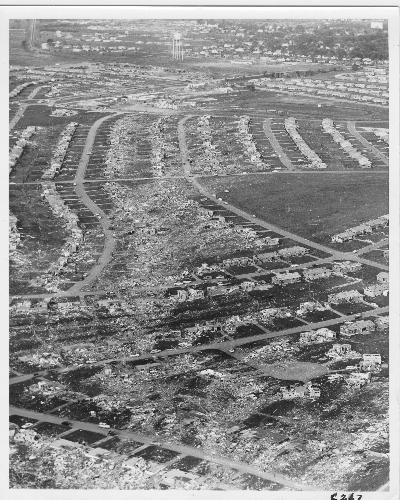 | 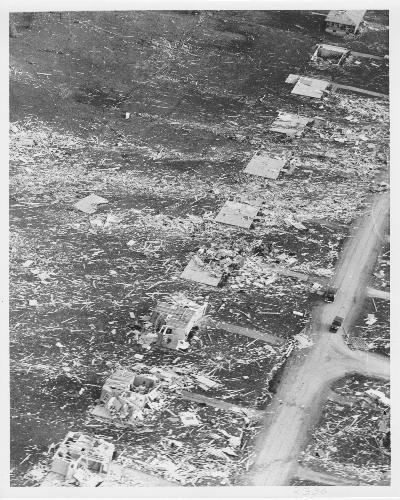 | 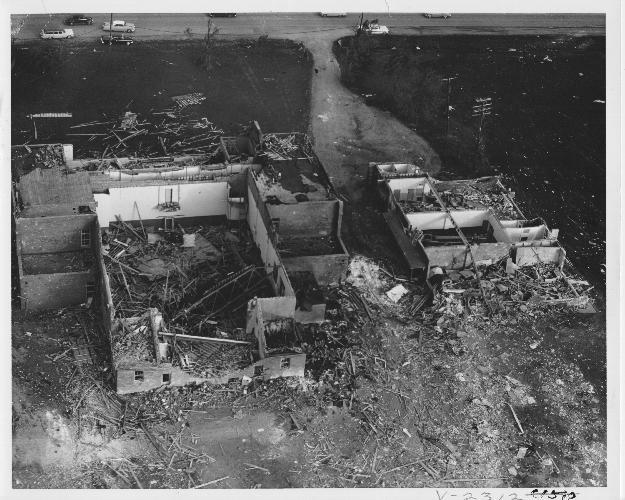 |
| Figure sixteen. Aerial shot of tornado path through Hickman Mills and Ruskin Heights. Courtesy of Kansas Urban center Star. | Figure 17. Damage to homes. Courtesy of Kansas City Star. | Figure 18. Damage to Ruskin Junior Loftier School. Courtesy of Kansas Metropolis Star. |
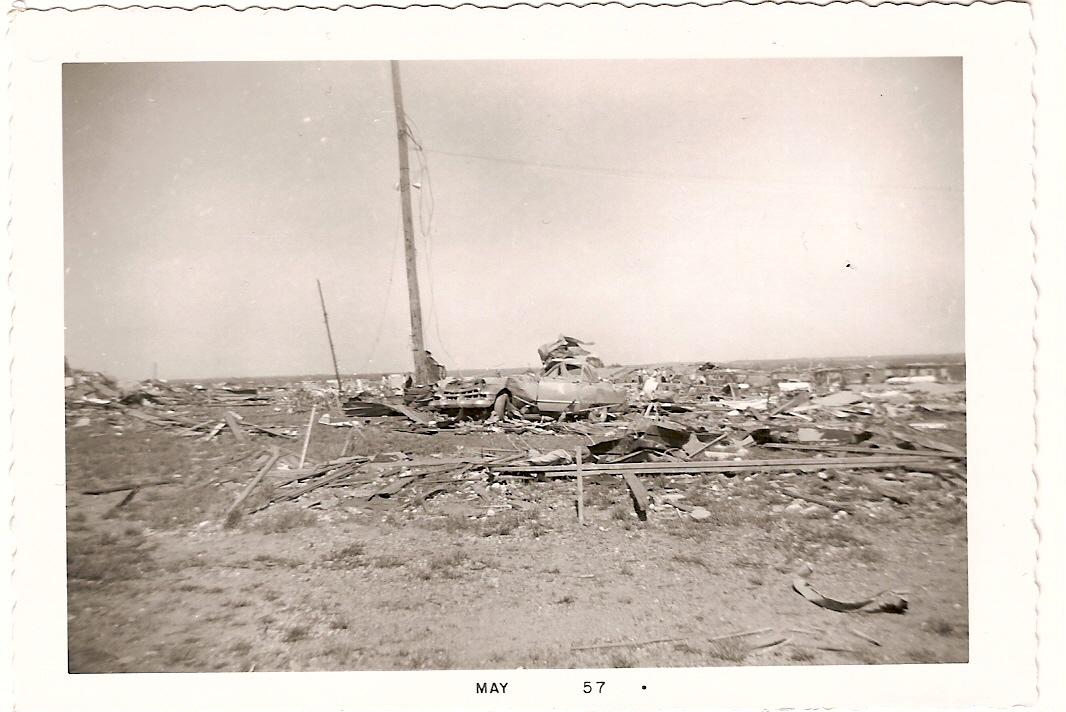 | 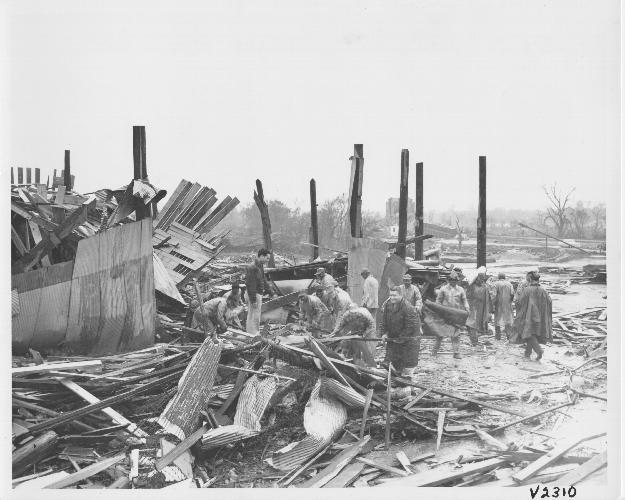 | 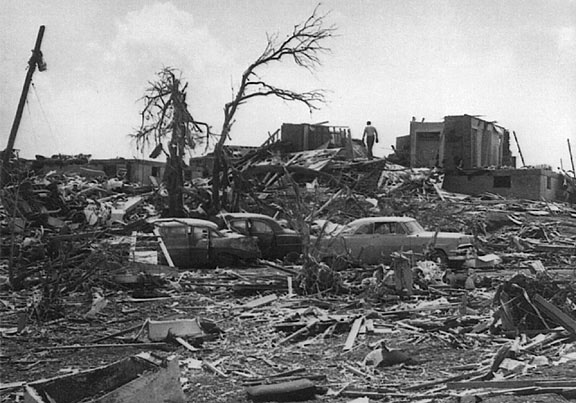 |
| Figure 19. Harm to automobile. Photograph courtesy of Joyce Rew (tornado survivor) | Figure 20. Harm to bu siness. Photo courtesy of Kansas City Star. | Effigy 21. Damage to abode in Hickman Mills. Photo courtesy of Kansas City Times. |
Acknowledgements
Numerous individuals contributed to the development of this web page. Transcripts of the event from Mr. Joseph Audsley provided a outset-hand account of the tempest's development. Mr. Allen Pearson's and Mr. Hugh Crowther's narrative of the event provided information on the evolution of the tempest and it'due south human toll. Carolyn Brewer, writer of a volume detailing the human touch of the storm, "Caught in the Path", provided information nearly several photographs used on this page. Mr. Tim Janicke of the Kansas City Star provided a historical perspective on the high-resolution epitome of the tornado nearly Bound Hill, Kansas. Dr. Charles Doswell provided two high resolution images of the tornado virtually Ottawa, Kansas. Mr. Jonathan Finch of the National Conditions Service Forecast Function in Dodge City, Kansas deserves special recognition for his aid in the development of the meteorological data analysis. A dog-earred copy of "A Kansas City Area Guide to Severe Thunderstorms and Tornadoes" past Dr. Charles Doswell and Mr. Fred Ostby, formerly of SELS, provided additional data about the meteorological state of the atmosphere on May twenty, 1957. Finally, to the staff of the National Atmospheric condition Service Forecast Office in Pleasant Hill for providing their assistance in developing this folio.
What Size Of Tornado Hit Kcmo Today,
Source: https://www.weather.gov/eax/RuskinHeights
Posted by: fortierhiverced.blogspot.com


0 Response to "What Size Of Tornado Hit Kcmo Today"
Post a Comment